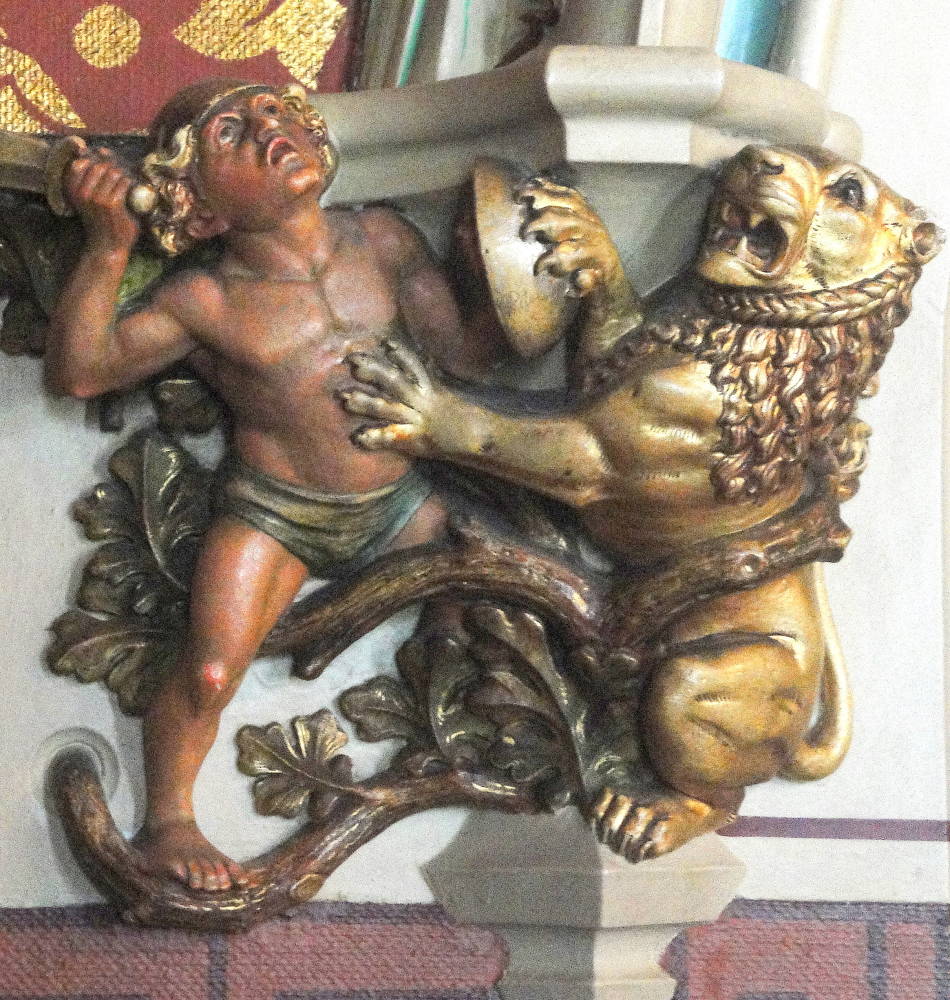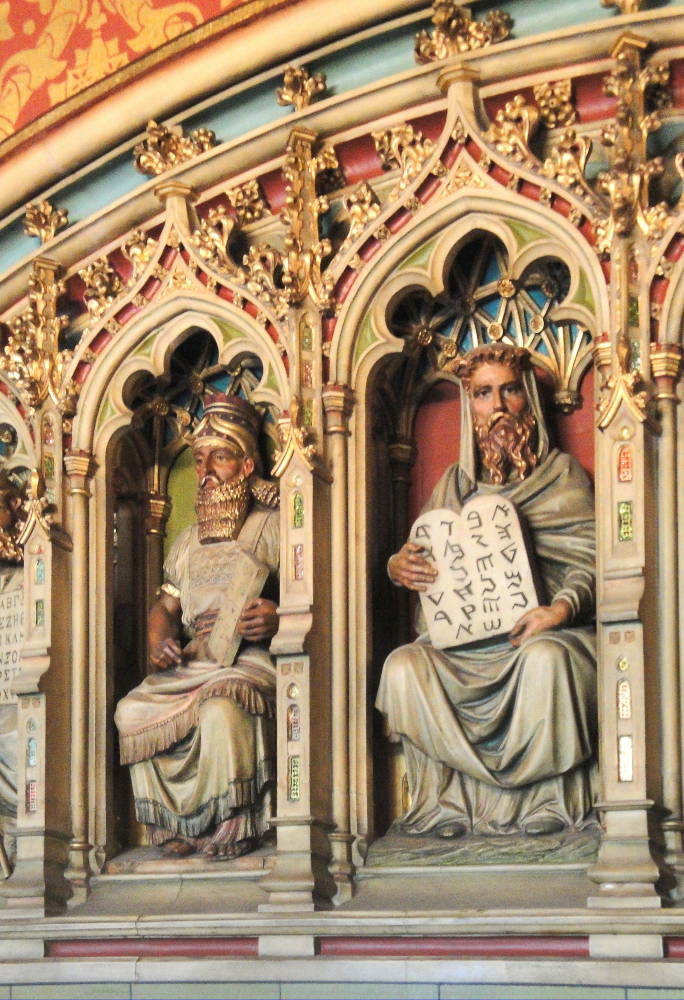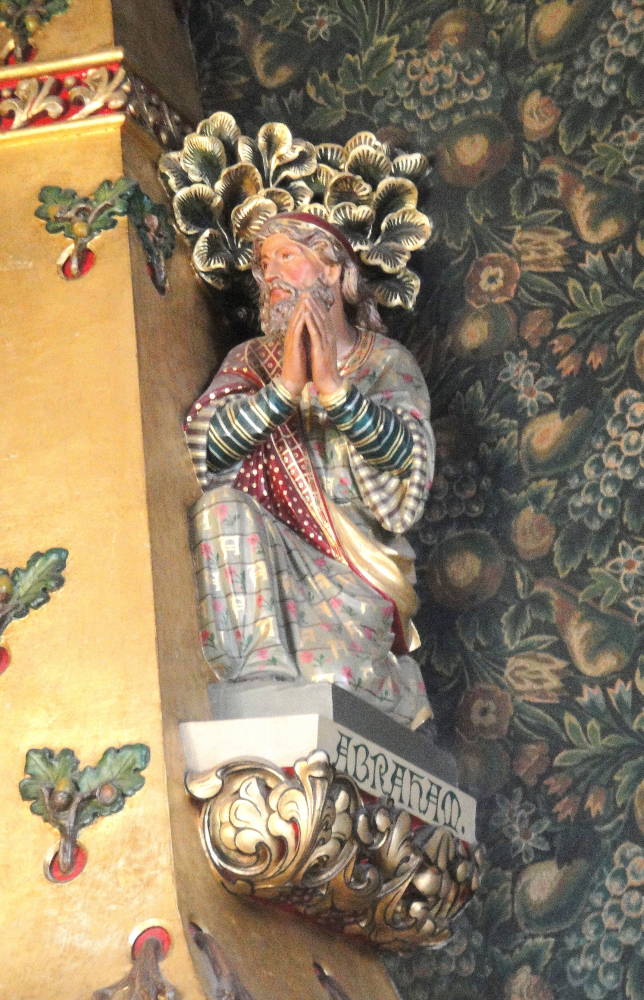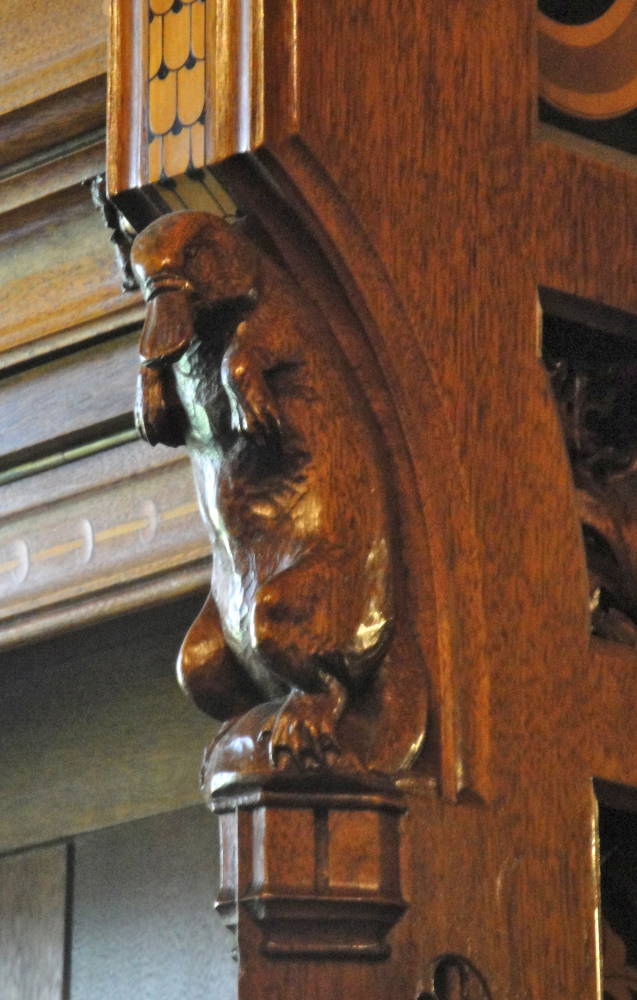Photographs by Robert Freidus and Jacqueline Banerjee. Text by Banerjee and George P. Landow, who did the formatting. [Click on thumbnails for larger images. You may use these images without prior permission for any scholarly or educational purpose as long as you (1) credit the photographer and (2) link your document to this URL.]

The Library, like the Banqueting Hall, occupies the site of the old medieval hall. The larger spaces here come as something of a relief after the small rooms and narrow passageways of the castle's towers. With its rich, warm tones, it is perhaps the pleasantest room in the entire castle. Here, part of the original Victorian heating system is skilfully hidden below the substantial wooden desk to the left, behind decorative grilles. Burges drew up the designs for this in 1879, and the heating itself was installed by the pioneering heating engineer, Wilson Weatherley Phipson (see Roberts 42). The whole room looks used, and user-friendly.



Left to right: (a) Library bookcase perpendicular to the walls. Two heroes: (b) St. George killing the dragon. (c) Hercules fights the lion.
The Darwinian Monkeys




As usual with work designed by Burges, the library contains some whimsical touches. Burges has a sly laugh at Darwin in the design around a doorway: while one monkey steals an apple from the Tree of Knowledge, another two have grabbed the Book Of Truth, and one of these is looking into it with great perplexity.
The Fireplace with the languages of antiquity



Fireplace by Thomas Nicholls. Left to right: (a) Moses sits surrounded by figures representing ancient languages: Greek, Assyrian, Hebrew, Egyptian, and Celtic — with Bute himself portrayed as studying Celtic runes at the far right (The Strange Genius, 43). Both the large painted tile mural of Ezekiel in the roof garden and the fact that Moses holds the tablets conventionally signifying the ten commandments might suggest that Moses represents the law and his companions other law givers — Solon, Hammurabi, and so on. In fact, the tablets just contain the Hebrew alphabet and not the ten commandments (b) The Egyptian Pharaoh holding a tablet with hieroglyphics. (c) Moses rather incongruously depicted as a blond Nordic type. The Assyrian figure, although wearing middle-eastern garments, also has blond hair — the effect of using gold gilt. Entire fireplace.
Other wood carving both unpainted and painted




Left to right: (a) Mermaid and Merman. (b) Abraham. (c) A Duck-billed Platypus. (d) Leaves and a gilded spider behind. According to Matthew Williams, "The Library at Cardiff Castle contains all of its original furniture, and is the only complete interior by Burges in existence" (19).
Other Views of Cardiff Castle and Related Material
- The castle exterior
- The Winter Smoking Room
- The Bachelor Bedroom and bathroom (in the Clock Tower)
- The Summer Smoking Room
- The Arab Room and Banqueting Hall
- Lord Bute's Bedroom and Bath
- The Day Nursery
- The Roof Garden
A Select Bibliography
Crook, J. Mordaunt. "Burges, William (1827-1881)." Oxford Dictionary of National Biography. Online ed. Viewed August 2009.
Crook, J. Mordaunt.The Dilemma of Style: Architectural Ideas from the Picturesque to the Post-Modern. Chicago: University of Chicago Press, 1987.
Crook, J. Mordaunt.William Burgess and the High Victorian Dream. London: Murray, 1981.
Crook, J. Mordaunt, ed. The Strange Genius of William Burges, "Art-Architect," 1827-1881. Cardiff: National Museum of Wales, 1982.
Long, Helen. The Edwardian House: The Middle-Class Home in Britain, 1880-1914. Manchester: Manchester University Press, 1993.
McLees, David. Castell Coch. Cardiff: Cadw (Crown Copyright), rev. ed. 2005.
Marsh, Jan. William Morris & Red House: A Collaboration between Architect and Owner. London: Anova Books, 2005.
Muthesius, Stefan. The High Victorian Movement in Architecture, 1850-1870. London: Routledge, 1972.
Newman, John, et al. Glamorgan (Buildings of Wales, Vol. 3). New Haven: Yale University Press, 1995.
Norwich, John Julius, ed. Treasures of Britain: The Architectural, Cultural, Historical and Natural Heritage of Britain. Windsor: AA/Everyman, 2002.
Williams, Matthew. William Burges, 1827-81. Andover, Hants: Jarrold Publishing (Pitkin Guide), 2007.
Last modified 15 May 2020